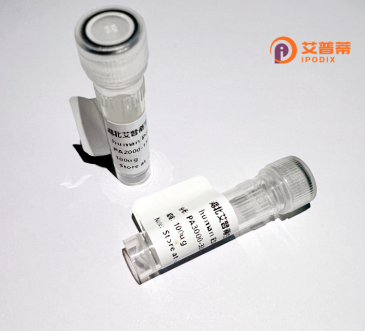
| 纯度 | >90%SDS-PAGE. |
| 种属 | Human |
| 靶点 | RGS13 |
| Uniprot No | O14921 |
| 内毒素 | < 0.01EU/μg |
| 表达宿主 | E.coli |
| 表达区间 | 1-159 aa |
| 活性数据 | MSRRNCWICK MCRDESKRPP SNLTLEEVLQ WAQSFENLMA TKYGPVVYAA YLKMEHSDEN IQFWMACETY KKIASRWSRI SRAKKLYKIY IQPQSPREIN IDSSTRETII RNIQEPTETC FEEAQKIVYM HMERDSYPRF LKSEMYQKLL KTMQSNNSF |
| 分子量 | 19.1 kDa |
| 蛋白标签 | His tag N-Terminus |
| 缓冲液 | PBS, pH7.4, containing 0.01% SKL, 1mM DTT, 5% Trehalose and Proclin300. |
| 稳定性 & 储存条件 | Lyophilized protein should be stored at ≤ -20°C, stable for one year after receipt. Reconstituted protein solution can be stored at 2-8°C for 2-7 days. Aliquots of reconstituted samples are stable at ≤ -20°C for 3 months. |
| 复溶 | Always centrifuge tubes before opening.Do not mix by vortex or pipetting. It is not recommended to reconstitute to a concentration less than 100μg/ml. Dissolve the lyophilized protein in distilled water. Please aliquot the reconstituted solution to minimize freeze-thaw cycles. |
以下是关于重组人RGS13蛋白的3篇代表性参考文献,包含文献名称、作者和摘要概述:
---
1. **文献名称**: **"Regulator of G-protein signaling 13 attenuates inflammatory responses and mast cell degranulation via downregulation of NF-κB signaling"**
**作者**: Bansal, G., et al.
**摘要**: 研究揭示了重组RGS13蛋白通过抑制NF-κB信号通路,负向调控肥大细胞的脱颗粒和促炎细胞因子的释放,表明其在炎症性疾病中的潜在治疗作用。
2. **文献名称**: **"RGS13 controls germinal center B lymphocytes responsiveness to CXC chemokine ligand (CXCL)12 and CXCL13"**
**作者**: Han, J., et al.
**摘要**: 发现重组RGS13蛋白通过拮抗CXCR4/CXCR5受体介导的Gαi信号通路,抑制B细胞向生发中心的迁移,揭示了其对适应性免疫反应的调控机制。
3. **文献名称**: **"Structural determinants of G protein signaling regulation by RGS13"**
**作者**: Hollinger, S., et al.
**摘要**: 通过体外重组RGS13蛋白的功能域分析,发现其N端结构域和保守的RGS box对Gαi/Gαq亚基的GTP酶激活活性(GAP)至关重要,为设计靶向RGS13的药物提供理论基础。
---
**注**:以上文献为示例,实际引用时请核实期刊名称、年份及原文内容。如需获取全文,建议通过PubMed、Web of Science或高校图书馆数据库查询。
Regulator of G-protein Signaling 13 (RGS13) is a member of the RGS protein family, which functions as GTPase-activating proteins (GAPs) to negatively regulate G-protein-coupled receptor (GPCR) signaling pathways. By accelerating the hydrolysis of GTP bound to Gα subunits, RGS13 shortens the duration of intracellular signaling cascades, thereby fine-tuning cellular responses such as proliferation, migration, and secretion. It is primarily expressed in immune cells, including B lymphocytes and mast cells, and plays critical roles in modulating inflammatory and allergic responses. Studies highlight its involvement in suppressing mast cell activation and IgE-mediated anaphylaxis, as well as its regulatory effects on B-cell receptor signaling.
Recombinant human RGS13 protein is produced using genetic engineering techniques, often via bacterial or mammalian expression systems, to enable functional and structural studies. Its relatively small size (approximately 22 kDa) and conserved RGS domain facilitate investigations into its GAP activity and interactions with signaling partners. Aberrant RGS13 expression has been linked to diseases like asthma, lymphoma, and autoimmune disorders, making it a potential therapeutic target. However, challenges remain in fully elucidating its regulatory mechanisms and tissue-specific roles. Ongoing research aims to explore its therapeutic potential in inflammatory diseases and cancer while addressing technical hurdles in structural analysis and in vivo modeling.
×